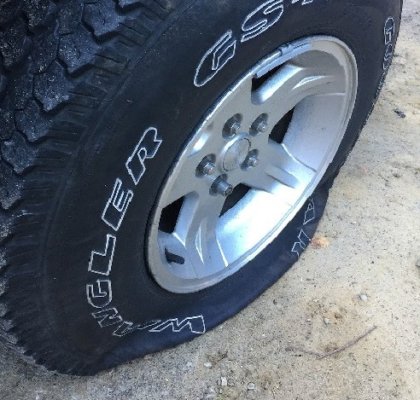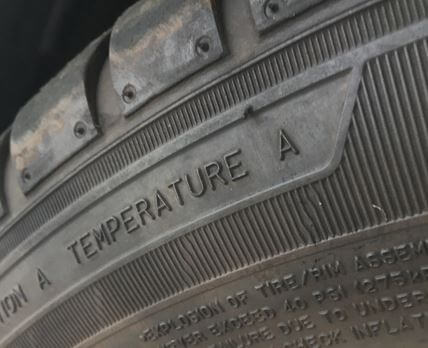
Story from my neighbor, earlier this week . . .
“I was on my way home, zipping along on the freeway when all of a sudden BOOM, the rear end of the car shot up like it had gone over something BIG, then came down with a tremendous thump! Scared me to death!”
When she got home, we saw what had happened. The tread on the right rear tire had exploded, separating from the tire, wrapping itself around the bumper, flapping and destroying the back fender before the car could be brought to a stop!
What does this story have to do with the coronavirus? Well, read on!
During COVID, drivers are facing an elevated level of danger!
What?!
It only took an hour or so before both the friend and I had done some research about this accident, and what we found became the basis for this Advisory. And what we found is really worth a warning or two.
One result of the COVID shut-down – you may have let your car just sit for days or even weeks.
When was the last time you drove your car? If it’s been a while, you may discover an unpleasant surprise the next time you go to look for it. For instance,
- The car may be gone. In some urban areas, COVID means people aren’t going to work, so their cars are parkeded without being moved for days and weeks. Perfect targets for thieves. (In LA, car thefts doubled during the month of June!) And even if your car was just taken for a joy ride, the Insurance Information Institute reports that the average car theft costs $8,407. So, check on your car and move it to where you can see it!
- The battery may be dead. Which of your friends has jumper cables and is willing to come by to rescue you? (And will your newly chosen parking place still be available when you finally get there?)
- You may have new occupants – wild animals! A car is a nice quiet, closed space, offering safety and comfort for rats, mice and/or squirrels. Not only can they build a nest under the hood or even inside, but they really like those tasty rubber wiring harnesses or hoses. (On this same topic, just yesterday I saw a “Ring video” of a bear going along, trying the handles of parked cars, finding a pick-up that was open, and crawling in! The owner of the pickup checked the footage in the morning when he looked out the window and saw the door still open!)
Now, raise your hand if you’ve ever experienced any of the above! If you’re lucky enough to be sitting there motionless, keep reading. You may have a chance to participate at the end of the next section of the Advisory!
We go back to my neighbor. She’s a reminder to us all to
Pay particular attention to tires – and in this case, underinflated tires in the heat.
Blowouts and tread separations like our neighbor experienced are more common in hot weather, anyway. But cars that have been parked for a while . . .? Here’s what to watch out for.
Are your tires underinflated?
If you look down at the tire of your parked car, you’ll see that the bottom of the tire bulges out just a bit, or “flexes,” where the weight is on it. (The picture above shows an exaggerated “flex” because this tire is definitely underinflated!) As the tire turns, the flex point changes. On an underinflated tire, the “flex” area will be greater and as the tire turns, it will generate more friction and thus more heat.
This is why every tire has a recommended inflation level. It is measured in pounds per square inch (psi). You’ll see the recommended psi on the side of the tire itself — probably something like 32 – 36 psi..
When you’re driving, the faster you drive the hotter the tire will get. Add more weight, and you’ll add heat, too. When the weather itself is hot, every 10 degrees of temperature can raise the temperature of the tires another degree or so.
When tires are underinflated, they will get even hotter because reduced pressure results in more flexing.
How hot do tires get? Drive on the highway for a half-hour, and tire temperatures will increase 50 degrees. If it’s 95 degrees out, as it was the day of my neighbor’s accident, the roadway itself was probably close to 150 degrees. (We have actually measured 149 degrees right here in front of the house using a thermal imaging camera.)
Add it all up and her tires may easily have reached as high as 200 degrees! And if her tires were underinflated . . .?!
Check for the “heat” rating of your tires.
Tires are rated A, B and C, with A being best, for their ability to “run cool.” I ran out to check my own tires and here’s a picture of the tire and rating.

The point of it all? You can’t impact the weather, or the temperature of the road.
But you can easily keep your tires inflated per the tire recommendation.
This means you need to check them regularly, when the tires are cool, using a good quality tire gauge. We have several gauges in the car all the time – at least one of the inexpensive “pencil” type gauges, and also an easier to read circular gauge like this one, from Amazon:

Check the overall condition of your tires, too.
Just sitting, tires lose a pound or two of pressure in a month. So when you check the tire pressure, particularly if you notice a loss in tire pressure, look for damage. The best way to really inspect your tires is when they are clean. (Getting off the dust and dirt and oil build-up will help your tire shed heat, too.)
Here’s what to look for:
- Is tread wear even? If your tires have worn tread on the outside but thicker tread on the inside you need to find out about an alignment!
- Do you see any bulges?
- What about cracks along the tread or sidewall? Don’t forget the inside of the tire, too.
- What’s the condition of the valve stem and valve cap?
Protect your tires from drying out and cracking.
You can also apply a protectant, typically wax-based, that will help keep tires clean longer, give them a nice shine, and protect them from drying out.
There are dozens of car products aimed at cleaning, restoring, lubricating, and rehydrating your tires. Read all the product info carefully to be sure you are getting protection and not just shine.
Apply on very clean tires. Don’t over apply! Follow directions on how to apply and how to let it dry and/or buff. Be sure to keep excess off the paint and brakes. If you’re using a spray, be aware that the spray may stain the concrete floor around the wheel. We have resorted to parking on an old towel!
Car tire products are fun and not too expensive.
You can get a couple or maybe even three to try for less than $20. Here are two we have used over the years. (Car buff friends always have their favorites, so ask around!) Click and you’ll go to Amazon, where we are Associates and may get a commission if you buy.
A GEL product from ArmorAll

And a FOAM product (”Just spray and walk away!”) from Meguiars

Taking care of your car is always worth it. But today, with people driving less and at the same time faster and/or more erratically (!), it’s a good idea to head out today to check the condition of your tires.
I hope you’ll find them in good shape!
Virginia
Your Emergency Plan Guide team
P.S. If you are taking another look at your car in terms of general preparedness, don’t overlook our earlier Advisory about emergency car supplies “to get you home.” Here’s the link.
P.P.S. This has been a fun Advisory for me to write! Reminded me of trying all sorts of car care products on my own “daily driver” that I cherished for 33 years.

Don't miss a single Advisory.
Thank you for subscribing.
Something went wrong.
